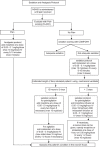The Comparison of Cerebral Oxygenation among Mechanically Ventilated Children Receiving Protocolized Sedation and Analgesia versus Clinician's Decision in Pediatric Intensive Care Unit
- PMID: 38292279
- PMCID: PMC10824216
- DOI: 10.4103/jets.jets_158_22
The Comparison of Cerebral Oxygenation among Mechanically Ventilated Children Receiving Protocolized Sedation and Analgesia versus Clinician's Decision in Pediatric Intensive Care Unit
Abstract
Introduction: Adequate sedation and analgesia are two crucial factors affecting recovery of intensive care patients. Improper use of sedation and analgesia in intensive care patients may adversely lead to brain oxygen desaturation. This study aims to determine cerebral oxygenation as measured by near-infrared spectroscopy (NIRS) and inotropic interventions received among mechanically ventilated children in the pediatric intensive care unit (PICU).
Methods: This study is a nested case - control study in the PICU of Indonesian tertiary hospital. Children aged 1 month to 17 years on mechanical ventilation and were given sedation and analgesia were included in the study. Subjects were divided into two groups according to the protocol of the main study (Clinical Trial ID NCT04788589). Cerebral oxygenation was measured by NIRS at five time points (before sedation, 5-min, 1, 6, and 12 h after sedation).
Results: Thirty-nine of the 69 subjects were categorized into the protocol group and the rest were in the control group. A decrease of >20% NIRS values was found among subjects in the protocol group at 5-min (6.7%), 1-h (11.1%), 6-h (26.3%), and 12-h (23.8%) time-point. The mean NIRS value was lower and the inotropic intervention was more common in the control group (without protocol), although not statistically significant.
Conclusion: This study found that mechanically ventilated children who received sedation and analgesia based on the protocol had a greater decrease of >20% NIRS values compared to the other group. The use of sedation and analgesia protocols must be applied in selected patients after careful consideration.
Keywords: Analgesia; brain oxygenation; case–control study; children; near infrared spectroscopy; sedation.
Copyright: © 2023 Journal of Emergencies, Trauma, and Shock.
Conflict of interest statement
There are no conflicts of interest.
Similar articles
-
Effectiveness of Protocolized Sedation Utilizing the COMFORT-B Scale in Mechanically Ventilated Children in a Pediatric Intensive Care Unit.J Pediatr Intensive Care. 2019 Sep;8(3):156-163. doi: 10.1055/s-0039-1678730. Epub 2019 Feb 15. J Pediatr Intensive Care. 2019. PMID: 31402992 Free PMC article.
-
Nurse-driven pediatric analgesia and sedation protocol reduces withdrawal symptoms in critically ill medical pediatric patients.Paediatr Anaesth. 2015 Aug;25(8):786-794. doi: 10.1111/pan.12649. Epub 2015 Mar 24. Paediatr Anaesth. 2015. PMID: 25810086
-
Successful implementation of a pediatric sedation protocol for mechanically ventilated patients.Crit Care Med. 2011 Apr;39(4):683-8. doi: 10.1097/CCM.0b013e318206cebf. Crit Care Med. 2011. PMID: 21263324
-
Protocol-directed sedation versus non-protocol-directed sedation in mechanically ventilated intensive care adults and children.Cochrane Database Syst Rev. 2018 Nov 12;11(11):CD009771. doi: 10.1002/14651858.CD009771.pub3. Cochrane Database Syst Rev. 2018. PMID: 30480753 Free PMC article.
-
Importance of the use of protocols for the management of analgesia and sedation in pediatric intensive care unit.Rev Assoc Med Bras (1992). 2016 Sep;62(6):602-609. doi: 10.1590/1806-9282.62.06.602. Rev Assoc Med Bras (1992). 2016. PMID: 27849239 Review.
References
-
- Zuppa AF, Curley MA. Sedation analgesia and neuromuscular blockade in pediatric critical care: Overview and current landscape. Pediatr Clin North Am. 2017;64:1103–16. - PubMed
-
- Sanavia E, Mencvi S, Lafever SN, Solana MJ, Garcia M. L rciar.Cli J. Sedative and analgesic drug rotation protocol in critically Ill children with prolonged sedation: Evaluation of implementation and efficacy to reduce withdrawal syndrome. Pediatr Crit Care Med. 2019;20:1111–7. - PubMed
-
- Sutadi K, Pudjiastuti P, Martuti S. Risk factors for mortality in children with shock in the hospital intensive care room dr. Moewardi Surakarta. Sari Pediatr. 2020;22:7–12.
-
- Haque A, Siddiqui NR, Munir O, Saleem S, Mian A. Association between vasoactive-inotropic score and mortality in pediatric septic shock. Indian Pediatr. 2015;52:311–3. - PubMed
LinkOut - more resources
Full Text Sources

